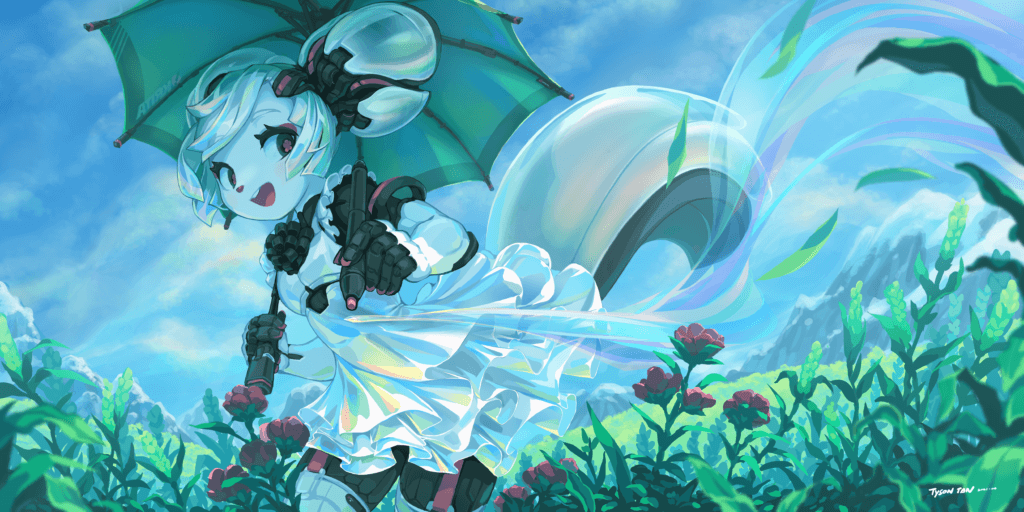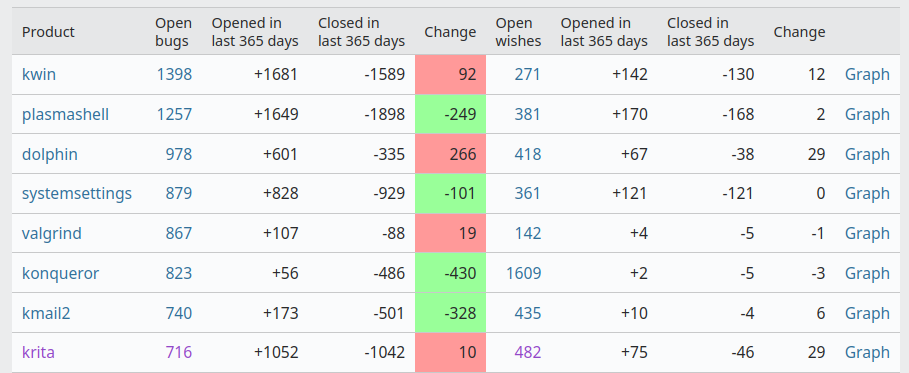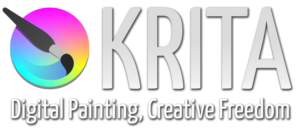Krita under 2022 och 2023
Det här är vår, mycket sena, årliga översikt över det gångna året, och vi ser fram emot året som precis har börjat. Om sånt tråkar ut dig, hoppa gärna över det!

Liksom 2021 och 2020 dog inga medlemmar i Krita-teamet i den pågående pandemin. Det känns rätt mirakulöst, men så är det faktiskt. Året var dock ganska hemskt, med Kritas underhållsansvariga som fick lång covid (det är jag, Halla ...) och var för sjuk för att göra något fyra dagar av sju, och olika andra omvälvningar som vi inte går in på i detalj eftersom det inte skulle vara säkert, eller vara för privat för att tala om. Vi hade verkligen ett riktigt tufft år.
Åren innan 2022 präglades mest av att vi, ibland desperat, försökte hålla koll på antalet felrapporter som strömmade in. Det måste erkännas att många felrapporter i princip inte går att åtgärda. Det är inte att skylla på rapportören som gått igenom allt som behövs för att registrera sig och sedan skriva in sitt problem. Vilket verkligen är en beundransvärd ansträngning. Men alltför ofta är problemen med operativsystemets stöd av ritplattor, bildskärmsdrivrutiner ... eller helt enkelt missförstånd. Och rop på användarsupport. Men det finns nu fler öppna felrapporter än för ett år sedan.

Så för i år bestämde vi oss för att använda ett annat tillvägagångssätt. Vi vill proaktivt bestämma vad vi vill arbeta med, och sedan diskutera hur man gör det, och sätta igång, istället för att bara reagera på felrapporter, önskemål och funktionsförfrågningar.
Så, i början av 2022, så fort upphävandet av nedstängningar tillät, satt två av Krita-utvecklarna, Halla och Wolthera, tillsammans i Deventer för att förbereda idén. Naturligtvis, även innan invasionen av Ukraina och alla problem som det orsakade, kunde vi inte få ihop en fullständig Krita utvecklingssprint. Så det blev begränsat.
Vi satte oss ner, vi två, och diskuterade vilka Kritas huvudsakliga kommersiella konkurrenter var. Ja, det är förstås Clip Studio. Photoshop gör i själva verket inte några förbättringar när det gäller målningsstöd, och Corel Painter är inte ett program vi skulle använda som vårt exempel: vi vill ta fram det mest effektiva programmet att skapa nya målningar med. Att förvandla foton till något måleriskt är inte vårt mål.
Resultatet av det var ett dokument där vi försökte identifiera det viktigaste som saknades, eller var undermåligt, i Krita. Det här är vad vi kom fram till:
- Textobjektfunktioner
- Enstaka bilder mot böcker eller projekt
- Expanderad framsida
- Molnintegrering
- Ett mobilt användargränssnitt
- Kalkering av tredimensionella modeller
- Flexibla serierutor
- Vektorpenslar
- Förbättringar av lagerhantering
- Hantering av projekttillgångar
- Nytt fyllverktyg
Sedan hade vi ett virtuellt möte med hela gruppen med sponsrade utvecklare, och lät dem välja saker som de var intresserade av:
- Dmitry skulle fokusera på att dela upp logiken i penselredigering så att vi kunde skapa nya gränssnitt för penselredigering utan att ta sönder penselgränssnitten. Det är nu klart.
- Textobjekt. Genom att göra en tydlig skillnad mellan textobjektet och textverktyget lade Wolthera ner ett enormt arbete på att förbättra textobjektet. (Observera: det betyder att själva textverktyget inte har uppdaterats, så man måste tillhandahålla obehandlad SVG för tillfället.) Textobjektet stöder nu SVG2 och CSS, med radbrytning och allt. Den här bilden visar resultatet av hennes arbete:

Det är nu också mestadels gjort och infogat.
- Agata har arbetat med att förbättra användarupplevelsen av Kritas guidefunktion och har för avsikt att arbeta med flexibla serierutor. Det första är nu under granskning (1, 2), det andra måste fortfarande påbörjas från konstruktion och vidare.
- Sharaf har arbetat på att konvertera välkomstsidan till QML och för att göra den mer flexibel och användbar. Det går långsamt, eftersom han också behöver underhålla Krita på Android och ChromeOS och de frekventa ändringarna av programmeringsgränssnittet gör det utmanande. En annan utmaning är KDE:s QML-ramverk, Kirigami, som är i en permanent förändring och inte är så stabilt som vi hade hoppats.
- Emmet (och före december 2022 Eoin) arbetar med att se över ljudstödet i animeringssystemet. Tekniskt sett är det klart, men det finns problem med att bygga stödbiblioteken på alla plattformar.
Och vad gäller fel, fixade vi förstås mer än tusen rapporter.
Vi har också gjort ett antal utgåvor:
- 5.0.6: 27-04-2022, utgivningsmeddelande
- 5.0.8: 25-05-2022, som var enbart en källkodsutgåva för att rätta en byggregression för Linux-distributioner med Qt > 5.12.
- 5.1.0: 18-08-2022, utgivningsmeddelande, release notes
- 5.1.1: 13-09-2022, utgivningsmeddelande
- 5.1.3: 7-11-2022, utgivningsmeddelande (Det finns ingen 5.1.2)
- 5.1.4: 14-12-2022, utgivningsmeddelande
Även om vi inte lyckades få in Krita i macOS butik (INTE iPadOS), sandlådan för butiksprogram i macOS besegrade oss fullständigt, och vi lyckades inte hitta ett sätt att få det att fungera. Ännu. På butiksfronten, när vi pratar om det, såg vi inte en enorm nedgång i butiksförsäljningen på Steam eller Windows, även om det märktes. Google Play och Epic tog bara in fickpengar.
Med tanke på den enorma stressen alla är utsatta för, är det naturligt att Kritas utvecklingsfond och de äldre utvecklingsfonderna samt enstaka donationer efter nerladdningar skulle minska. Det skedde, men på plussidan fick vi vår första företagssponsorn: Intel:


Men om vi vill fortsätta så här, så behöver vi mer pengar, det finns inget annat sätt. Innevarande år, 2023, blir ett år av total osäkerhet.
När det gäller sponsrade utvecklare har vi nästan hela teamet kvar: Sharaf, Dmitry, Halla, Wolthera, Tiar, Emmet, Ivan, Amy. Eoin lämnade oss i slutet av året för att börja arbeta på Godot, ett annat riktigt intressant fritt programvaruprojekt.
Men vi var plågade av regressioner, inte ens vår svit av enhetstester kunde förhindra innan utgivning. Det är dock något cykliskt. Utgivningar av Krita verkar gå från stabilt till stabilt till beklagligt till stabilt som svar på något, något som vi inte har förstått. Det är naturligtvis därför vi gör beta-utgåvor. Prova dem gärna!
Sammantaget var 2022, som sagt, tufft. Vi gjorde fantastiska framsteg med tanke på begränsningarna. Men det var ett år som prövade humöret, både i utvecklargemenskapen, såväl som i den bredare Krita-gemenskapen, inte bara den del av gemenskapen som faktiskt pratar med utvecklarteamet, utan också fristående gemenskaper som Discord och Reddit.
Folk blev ofta förbannade på vad de såg som bristande lyhördhet från "utvecklarna". Även om krita-artists.org är en stor framgång och en plats där folk verkligen hjälper varandra, är det också sant att det är omöjligt för Kritas utvecklare att läsa alla förslag och önskemål om funktioner och kolla in de ofta otroligt detaljerade förslagen. Vi kan helt enkelt inte hänga med!
Så om du vill engagera dig i att få Krita att växa och förbättras måste du ta kontakt med Kritas utvecklare direkt. Antingen på IRC (eller Matrix), genom att göra en sammanfogningsförfrågan på invent.kde.org eller via e-postlistan. Och även då, kom ihåg att vi bekämpar en flod av felrapporter samtidigt som vi försöker implementera funktioner och förbättringar som vi redan har bestämt oss för ska ha högsta prioritet.
Vad kommer att hända 2023?
Förmodligen mycket försenade kommer vi att ge ut Krita 5.2.0. Det blir försenat eftersom många medlemmar av gruppen är utmattade och behöver en längre paus än vanligt efter att ha arbetat fram till 2022. Problemen som plågade oss 2022 är inte borta, och några av oss har varit tvungna att flytta till nya länder, antingen påtvingat eller för att studera. Och jag har bara haft energi till projektledning, och knappt gjort någon kodning!
Men Krita 5.2.0 kommer att ha allt, eller det mesta, av arbetet som listats ovan. Du kan spåra vad som finns i Krita 5.2.0 med hjälp av milstolpefunktionen i KDE:s Gitlab, medan vi arbetar med versionsfakta: [milstolpar](https://invent.kde.org/graphics/krita/-/milestones/5#tab -sammanfogningsförfrågningar). Efter 5.2.0 kommer vi att arbeta med felrättningsutgåvor, och naturligtvis de andra sakerna från vår prioriteringslista som inte ännu har påbörjats.
Om du vill få det att ske, stöd gärna Krita, antingen med ett engångsbidrag, en [prenumeration på utvecklingsfonden](http ://fund.krita.org) eller genom att skaffa Krita i en av de programbutiker som stöds.